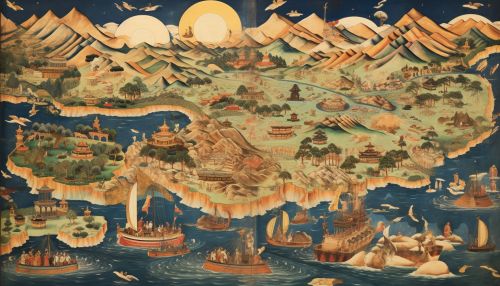Gupta Empire
Early History
The Gupta Empire was an ancient Indian empire existing from the mid-to-late 3rd century CE to 543 CE. This period is called the Golden Age of India and was marked by extensive inventions and discoveries in science, technology, engineering, art, dialectic, literature, logic, mathematics, astronomy, religion, and philosophy that crystallized the elements of what is generally known as Hindu culture.
Origin
The Gupta Empire was founded by Maharaja Sri Gupta; he was succeeded by his son, Ghatotkacha. Ghatotkacha had a son named Chandragupta I, who married a Licchavi princess named Kumaradevi, which established the beginning of the Gupta Empire.
Expansion under Samudragupta
Samudragupta, son of Chandragupta I, expanded the empire by undertaking campaigns across the Indian subcontinent. He ruled over a vast territory, from the Himalayas in the north to the river Narmada in the south, and from the Brahmaputra River in the east to the Yamuna River in the west.
Reign of Chandragupta II
Chandragupta II, son of Samudragupta, further strengthened the Gupta Empire by conquering the kingdoms of Shaka and Kushana. He also established diplomatic relations with the Chinese and the Romans. His reign was marked by prosperity and a flourishing of arts and sciences.
Decline of the Empire
The decline of the Gupta Empire began in the late 5th century and the early 6th century. The empire was weakened by the invasions of the Huna people and the rise of regional powers. The last known Gupta ruler was Vishnugupta, reigning from 540-550 CE.
Administration
The Gupta Empire was characterized by an efficient and highly organized bureaucratic structure. The empire was divided into provinces, each governed by a provincial governor. The provinces were further divided into districts, each headed by a district officer.
Economy
The economy of the Gupta Empire was largely based on agriculture, with the cultivation of staples such as wheat, barley, and rice. Trade and commerce also flourished during this period, with the empire maintaining trade relations with the Roman Empire and China.
Culture and Society
The Gupta period is known as the Golden Age of India because of the immense progress in the fields of arts, science, and literature. The period saw the composition of the Kama Sutra by Vatsyayana and the plays of Kalidasa. The decimal numeral system, including the concept of zero, was invented during this period.
Religion
Hinduism was the dominant religion during the Gupta period, with the rulers patronizing Brahmanical Hinduism. However, Buddhism and Jainism were also practiced and patronized by the Gupta rulers.
Art and Architecture
The Gupta period saw a flourishing of art and architecture. The Gupta style of architecture can be seen in the temples of Deogarh and Bhitargaon. The Ajanta and Ellora caves also bear witness to the artistic excellence of this period.
Legacy
The Gupta Empire left a lasting legacy in the form of its contributions to art, science, culture, and administration. The decimal system, the concept of zero, the works of Kalidasa, and the Kama Sutra are all contributions of the Gupta period.
See Also


